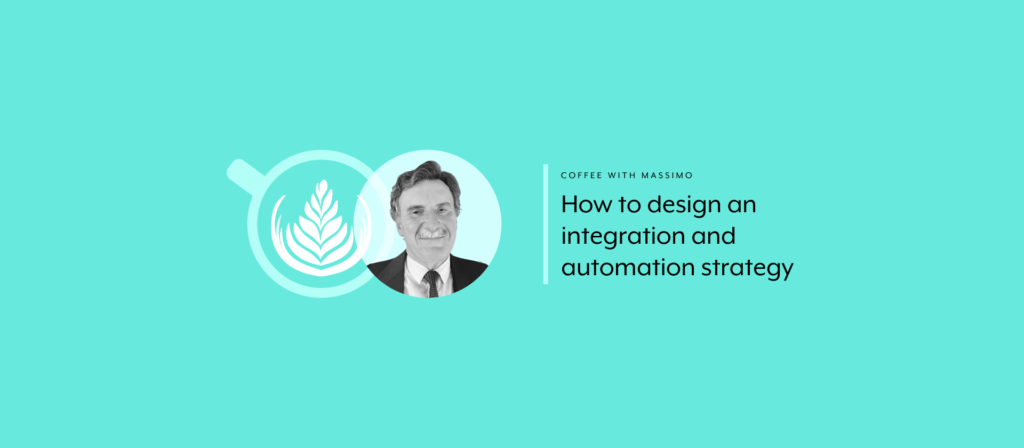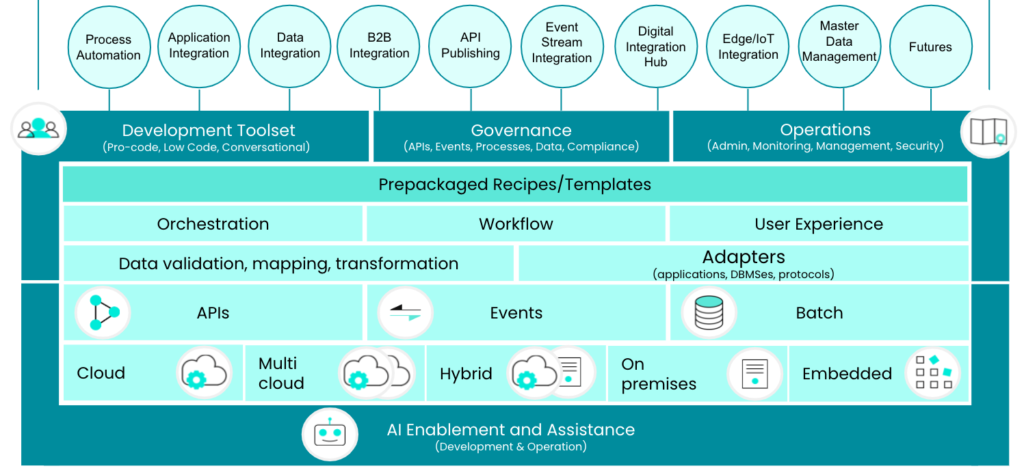For many organizations, an integration and automation strategy just consists of choosing a technology platform—but it’s not that simple.
An effective integration and automation strategy comes in two parts.
There’s a technology strategy, where your team adopts different types of integration and automation tools and delivers them as a shared platform; and there’s an operating model, where a centralized team establishes governance processes and enablement initiatives so that application teams and business functions can implement integrations and automations by themselves, yet safely and effectively.
Let’s dive into each of these areas so that you can implement a scalable, high-performing integration and automation strategy.

Want to learn more?
These insights come from our latest “Coffee with Massimo” webinar. You can watch the session’s full recording to catch everything Massimo shared!
Provide a shared integration and automation platform
Integration & automation can address countless use cases for your business.
Perhaps you need to integrate applications in order to move data between them; or engage in data integration to help your analytics teams perform business intelligence; or leverage RPA software to make existing processes more efficient; or integrate your trading partners in your company’s business processes.
Addressing these use cases (among others) usually requires adopting the appropriate combination of integration and automation platforms and tools. However, such a toolset should be seen and leveraged as a single platform, which is architected, operated, monitored, and delivered as a whole. In principle, this shared I&A platform should be made available to users as a shared service that every authorized organizational entity and individual can use in a self-service fashion.
This shared infrastructure should be accessible to multiple personas, from developers to SaaS administrators to non-technical business users; and it should allow for enforceable governance policies, an end-to-end operational experience of the platform, and—as a result—additional technologies specifically geared towards enforcing governance and security.
Clearly, implementing this type of shared I&A platform requires a team that can select, procure, deploy, and manage these tools and deliver them according to well-defined guidelines.
Related: What is software integration?
Establish your integration and automation strategy team
In the past, many organizations implemented an integration and automation team that focused on two areas:
- Developing the integration and automation strategy, which involves identifying use cases and opportunities, as well as the tools that optimally address them
- Implementing and managing all of the integration and automation projects on behalf of various entities, such as application teams, analytics teams, and business functions
Progressive organizations are expanding and changing the I&A team’s role. While it still owns the strategy, it’s now focusing more on governance, enablement, and support-related initiatives—versus implementation-related work—to encourage application teams and business functions to build integrations and automations themselves.
It’s worth noting that the I&A strategy team can work with colleagues from a variety of different backgrounds. This includes integration specialists who work in LoBs or subsidiaries; application developers, who need to consider integration and automation capabilities while building their applications; SaaS administrators, who need to tackle integration and automation use cases when implementing or updating their applications; and, in a growing number of cases, business technologists, that is, business users with some, if basic, technology skills.
Design your integration and automation strategy
Before investing time and resources into your technology and your operating model, you’ll want to think carefully about the strategy that’s best for your business.
To help you pinpoint the best strategy, you can consider the following in sequential order:
1. Business goals: As I discussed previously, automation can deliver a variety of business benefits, including efficiency, improved experiences, agility, real-time insights, and innovation.
Understanding your goals ultimately allows you to address the rest of the areas required in defining your strategy. For example, if you’re merely looking for efficiency improvements, you may look to outsource your efforts (using a solution integrator, for instance) or simply rely on your I&A strategy team for delivery. However, if you’re primarily looking to innovate your processes, you’ll want to keep the integration and automation implementations in-house and perhaps aim for a distributed delivery model.
2. Scenarios and use cases: This involves identifying the specific use cases you want to address, whether that’s application integration, process automation, mobile apps integration, APIs, B2B integration, etc.
3. Nonfunctional requirements: You’ll need to define your automations’ requirements from a variety of perspectives, including scalability, availability, reliability, SLA, security, and compliance.
4. Delivery model, governance and skills: Based on the goal(s) you’ve set, the answer to this question is likely clear: the more you look for efficiency, the more you focus on centralized delivery. The more you aspire to achieve agility and fast innovation cycles, the more you target decentralized delivery.
5. Architecture and technology platform(s): You need to procure technologies that support your functional and nonfunctional requirements and that enable the chosen delivery model—all while minimizing overlaps and underlaps. For example, if you want to enable business technologists, you must select platforms that support the notion of citizen integrator/citizen automator.
Going through this cycle isn’t a one-time effort. It requires consistent revisiting (perhaps yearly or bi-yearly) so that your strategy can accommodate to changes in business goals, scenarios, requirements, technology, and market realities.
Now it’s your turn: Start defining your integration and automation strategy today by thinking through each of the items above.

